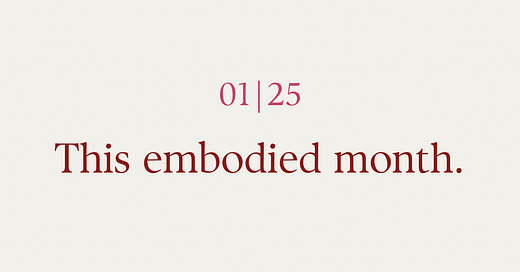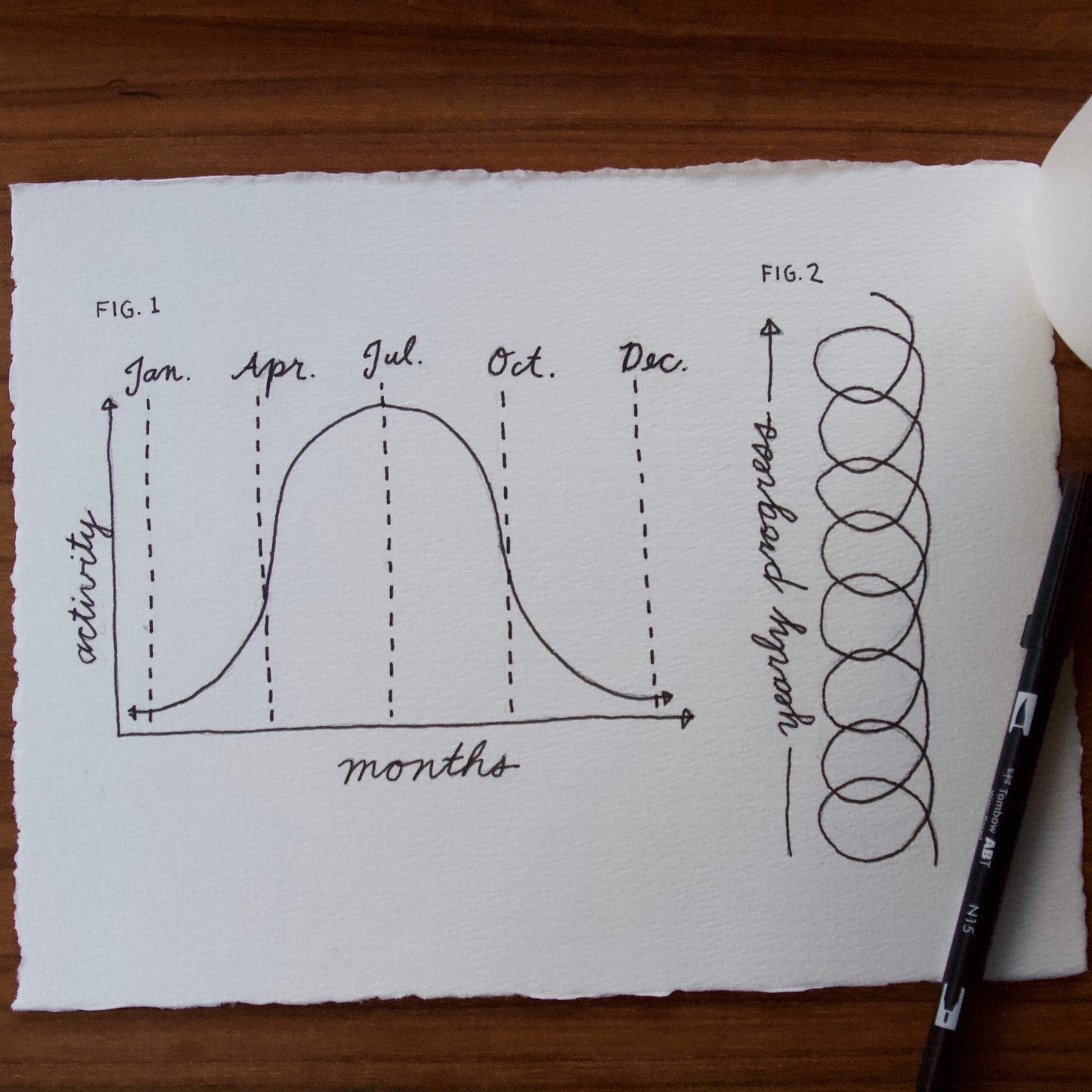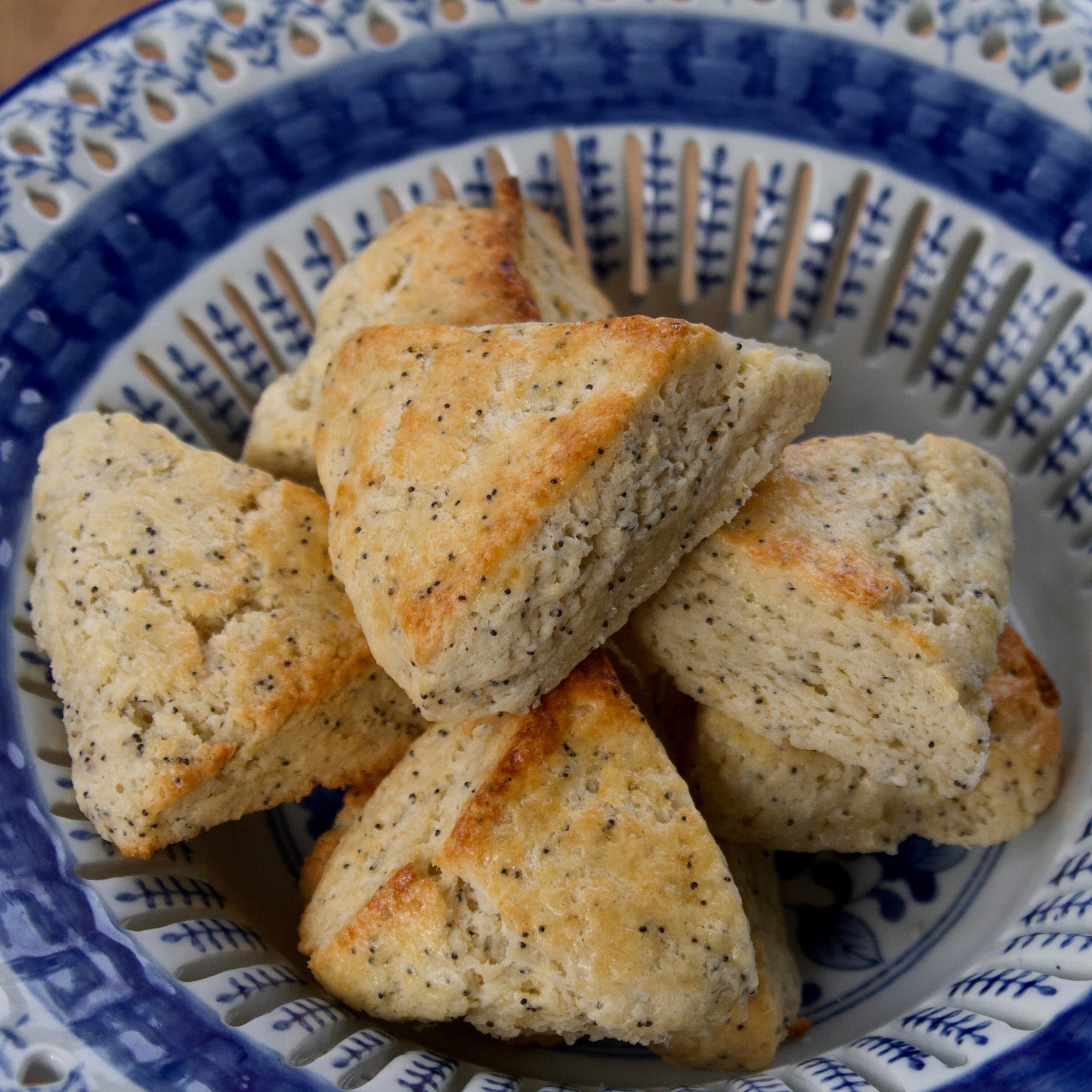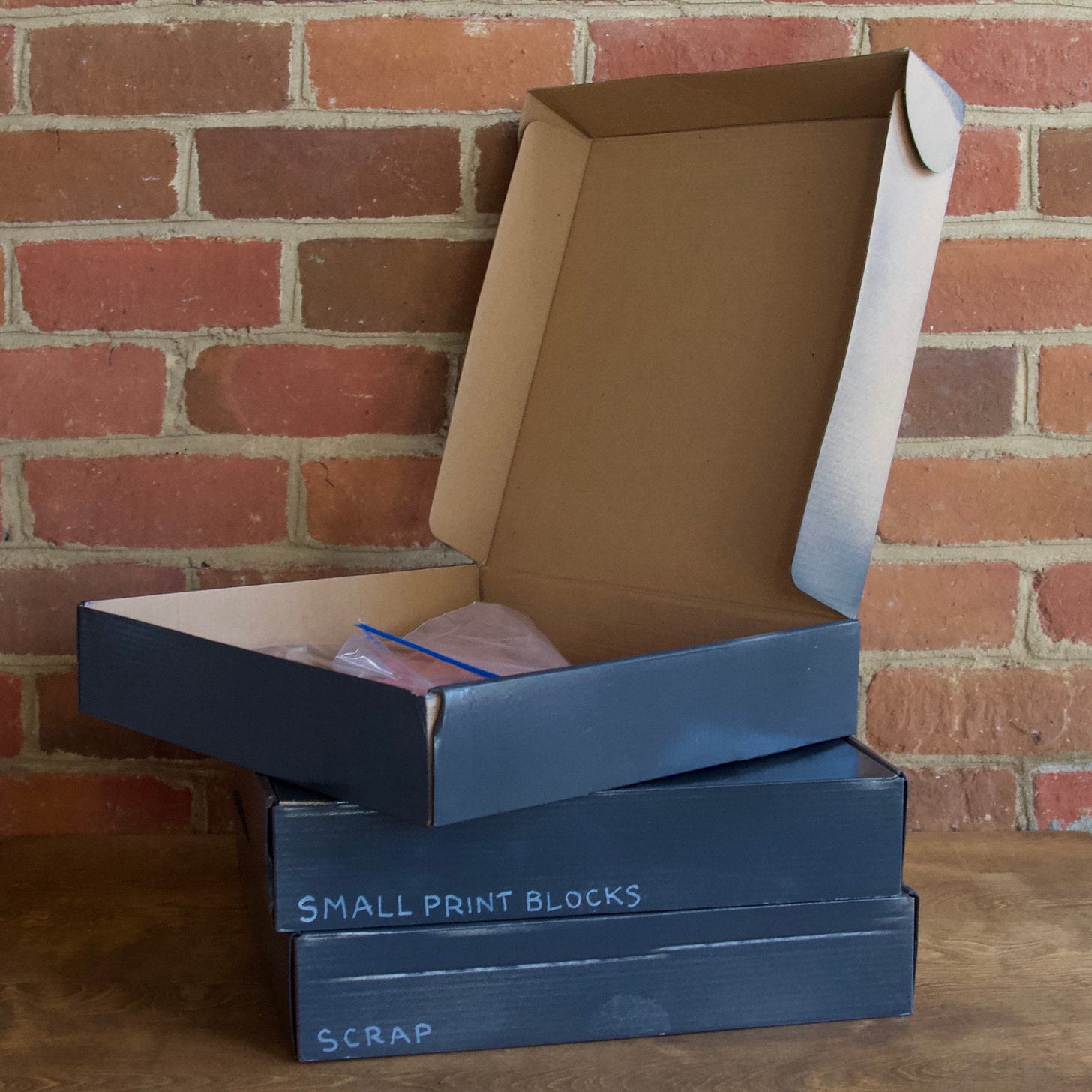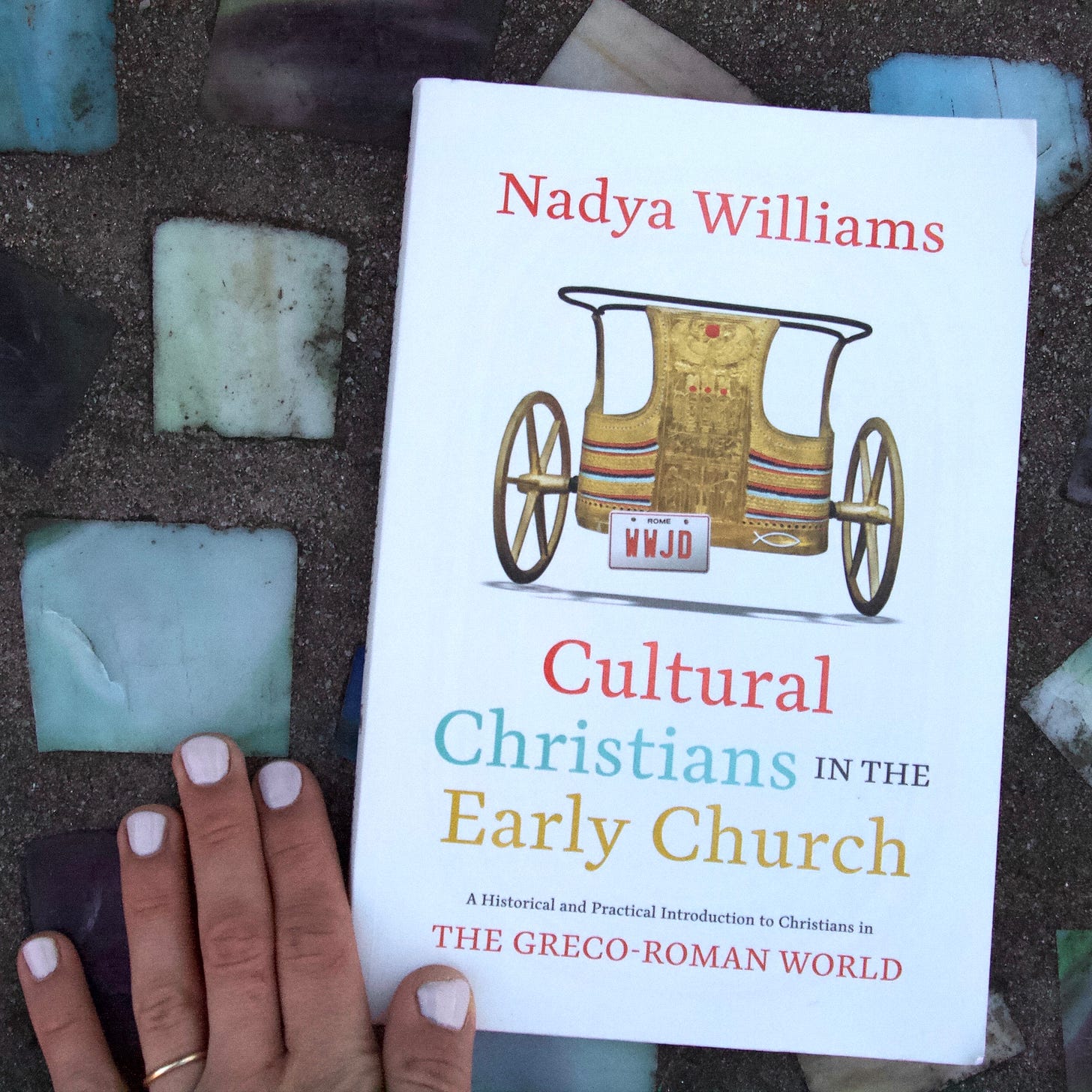01|25: This embodied month.
A monthly newsletter about God's grace in the little, precious, tangible particularities of a life.
Hi neighbors,
I realize it’s early in the month for me to be sending my newsletter, but I’m doing things a little differently this month, and given the theme of this post, which will soon become apparent, I’m thinking earlier is better than later. Also I’m presently snowed in with little else to do but write.
First, your important monthly reminders:
This is your monthly reminder that your Good Father delights in your non-aesthetic moments too.
This is your monthly reminder to let aesthetic beauty build in your heart a bright hope for a world that is to come rather than an anxious attachment to the world where moth and rust destroy.
This is your monthly reminder that whatever your heart is looking for, at the deepest level, it will be found in Christ—and if you are a member of the body of Christ, then it is most likely to find sustainable relief as you invest your whole self into the life of that body.
This is your monthly reminder to stay hydrated, to wear sunscreen, to eat plenty of protein and fiber, to move your body regularly in ways that feel good to you, to get enough sleep, and to floss your teeth. (Not because these habits make you a better person—just because they will make you feel better, body and soul!)
This is your monthly reminder that I am praying for you—by name or by email address if you are a subscriber, or in thought if you are just passing through. I firmly believe that the very God who created you loves you, delights in you, and desires to heal your pain and restore your heart to life and wholeness.
Now, without further ado, this is my embodied month—January 2025.
What is inspiring me?
Instead of sharing my current Pinterest dump, this month I’m going to get a little ~scientific~. (Trust me on this one: I went to magnet school, and I’m pretty sure this is basically what we learned…)
So, everybody knows about New Year’s resolutions. New year, new me. This is going to be my year! Girl, Wash Your Face. Let’s get ready to MANIFEST.
But since I inhabit the Evangelical Echo Chamber, my algorithm feeds me posts that read more like this: “New Years resolutions will always fail you! Stop striving! Christ doesn’t sanctify you according to the Gregorian calendar! Put your trust in grace, not in your own willpower!”
To which I say: easy there, tiger.
For sure, let’s lean on the grace of Christ, and let’s find peace in God’s perfect timing as he molds us towards our telos. But there’s something sweet about a tangible, fresh start! After a couple gluttonous holiday months, it’s refreshing to take practical steps back towards discipline and moderation.
The trouble with resolutions, I’d submit, is simply that we demand way too much motivation of ourselves during the least hospitable season for exertion. It’s cold. It’s dark. Even the atomic particles that constitute our bodies are telling us to move slowly.
I therefore like to think of seasonal activity as a bell curve (fig. 1). During the warm months, when activity comes easily, that’s the time to pursue progress. That’s the time to initiate a new or more strenuous exercise routine, to pick up the new hobby, to instill fresh habits that require concentrated effort. This past July I wrote a 60k-word first draft of a book within the span of four weeks like it was no big deal. Now? I’m calling it a good day if I remember to fold the laundry.
Around October, when the weather begins to chill and the calendar stacks up with holiday festivity, now it’s time to pause the projects, to adjust our focus from future to present, and to let ourselves enjoy the feasting and celebration.
January, then, does mark a fresh start. But it doesn’t need to be a fresh start unto progress and perfection! That’s the quickest way to burnout. January is time to take stock of what needs attention in our lives. It’s time to make plans—but not yet to act on them. It’s not time for progress; It’s time for maintenance. Sharpen your kitchen knives. Trim your split ends. Reintroduce more vegetable into your diet, but serve them over creamy, parmesan linguine.
Progress requires a solid foundation of maintenance and rest. A straight line upwards will topple easily. When I think of the progress I hope to make from year to year, I think of it as an upward spiral (fig. 2). God gave us seasons for a reason, and our bodies naturally understand this, if we will only listen to them. Take it easy, friends. It’s good for you to cozy up and rest every now and then. That’s science, folks. (Please don’t fact-check me.)
What am I eating?
You know what they say: When life gives you lemons, find a way to blog about it.
As much as I appreciate the work of agricultural engineering that has allowed us near constant access to whatever fresh produce we want, I sometimes recall what a miracle it is that God arranged for bright, invigorating citrus fruits to be in season during the bleakest months of the year. It’s like eating a bite of sunshine when you can’t get it from the sky.
This week my mom had a few extra lemons, which she passed on to me, and I gladly welcomed the gift as an opportunity to make a batch of lemon poppyseed scones. I’m not sure I’d ever tried a scone before I went to college in Illinois, but when I did, it seemed as though each of my new, Midwestern friends had a family recipe for scones they were eager to share. And I get it! Scones really are the perfect, cozy treat to get you through the bitter days of a Midwestern winter. Not too sweet, but plenty of butter to keep you full and happy.
In the years following college, I went through rounds of testing to perfect a scone recipe of my own, and I finally settled on one I was proud of. Lemon poppyseed is simply one variation on my master recipe.
I might get some shade for this, but I make my scone dough in a food processor. I do own a pastry blender, and for many years I swore by the traditional method of blending in the butter for the perfect “pea-sized” crumb consistency. But the food processor is so much easier and so much faster, and I genuinely prefer the texture of the scones this method produces over the traditional method. So do with that what you will!
Here’s the recipe, in case you want to try.
Into the bowl of your food processor add the following: 2 cups (250 grams) all-purpose flour; 2 teaspoons baking powder; 1/2 teaspoon salt; 1/4 cup granulated sugar; zest of 1 lemon; 1 Tablespoon poppy seeds; 2 sticks of cold, unsalted butter, both sliced and divided into 1-Tablespoon pats. Pulse everything a few times until you don’t see any more large chunks of butter.
Juice 1 lemon into a measuring cup, then top off the lemon juice with cold buttermilk until the liquid totals 3/4 cup. Pour the buttermilk and lemon juice into the food processor with the dry ingredients, and pulse just a few times, until the mixture forms a shaggy dough.
Dump mixture into a large mixing bowl, and work it with floured hands into two, compact balls. Press each ball down into a disc, about 6 inches in diameter and 1.25 inches thick; press the sides of the disc in to form a neat circle. Wrap each disc in plastic wrap, and let rest in refrigerator for at least 2 hours or overnight.
When you are ready to bake the scones, preheat oven to 425 degrees F. Line a rimmed baking sheet with parchment paper. In a small bowl, beat 1 egg yolk with 1 Tablespoon water. Remove dough from refrigerator and unwrap. Using a bench scraper or sharp chef’s knife, divide dough into eight triangular slices. Place scones on baking sheet 1 inch apart from each other, then brush tops lightly with egg wash. Bake for 22–25 minutes, or until tops have a light, golden-brown shine. Let cool on pan for a few minutes, and enjoy warm or at room temperature.
What ordinary object is dear to me?
I guess this is how it happens. One day you’re young and cool, and then at some point you find yourself saving the boxes your kids’ Christmas presents came in, spraying them with paint leftover from a previous project, and repurposing them for art supply storage, because, “Gosh, those are just some really good boxes.” But if this is what getting older feels like, I’m here for it.
What am I listening to?
Songs for a fresh start.
What am I reading?
I first became acquainted with Nadya Williams’s work back in October, when she was interviewed by Common Good Magazine about her new book, Mothers, Children, and the Body Politic: Ancient Christianity and the Recovery of Human Dignity. Given my personal educational background in Ancient Near Eastern history and archaeology, I immediately knew I would be a fan of Williams, who is a former professor of history and classics and is now—just like me—a stay-at-home, homeschooling parent.
I’ve enjoyed following Nadya on Substack, and I would recommend her newsletter to anyone interested in the intersections of history, community, culture, and faith. A couple months ago I actually reached out to Nadya to ask whether she had any advice on balancing the demands of homeschooling with one’s own creative career, and her response could not have been more warm or encouraging. It speaks volumes to me when a scholar, writer, etc., is willing to engage with those whom they inspire with such humility and kindness. Nadya’s work is all the more compelling to me now that I know the sincerity of her character.
I hope to read Mothers, Children, and the Body Politic soon, but I first wanted to read Williams’s earlier book, Cultural Christians in the Early Church, since it seemed more closely related to a personal project for which I am currently in the early research stage. I started Williams’s book while traveling for Thanksgiving, then got swept away by Christmas busyness, but it has been a delight to pick it back up.
In Cultural Christians, Williams corrects the nostalgic, idealized portrayal of Early Church that is common today with a balanced and realistic account, elucidating the many ways in which sin has always manifested itself in the church since its very beginning, regardless of its historical context.
It would have been easy to write such a book in a pessimistic and discouraging tone, highlighting the historical persistence of cultural Christianity as a way to denigrate the church. Williams, however, takes a gracious and tactful approach, such that the historical accounts she documents create a constructive appreciation for the common humanity of the church. Additionally, she brings historical accounts that may feel alien and unrelated to contemporary culture close to home, delineating the common thread of sin and temptation that has re-contextualized itself into new manifestations in the current day.
While I might have expected to walk away from Cultural Christians feeling cynical and blue, the book has instead left me encouraged and with many intriguing questions to chew on. I would absolutely recommend it.
Now what about you?
All recommendations—for recipes, for books, for movies, for music, for art, or for any other material experience that cheers your heart—are more than welcome in the comments. What are the rest of us missing out on that you just can’t wait to share with somebody?
Until next time—
Affectionate thanks,
HLS


